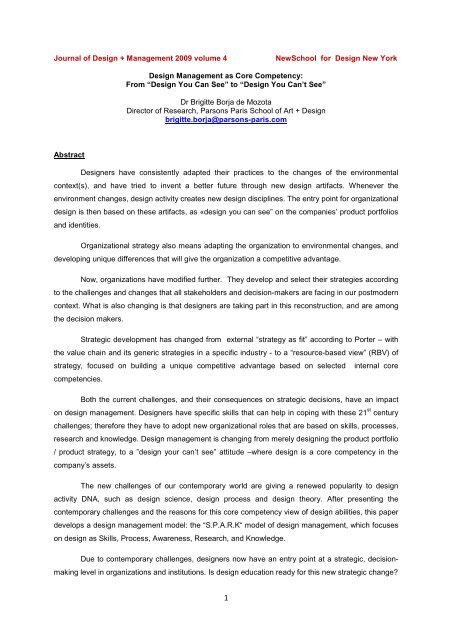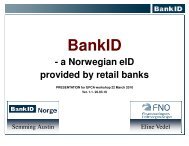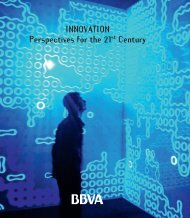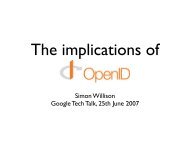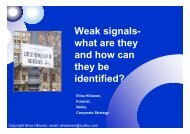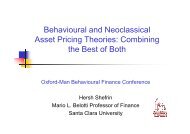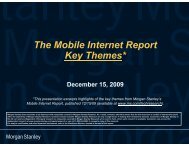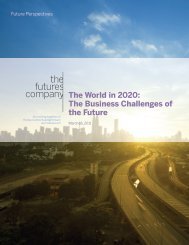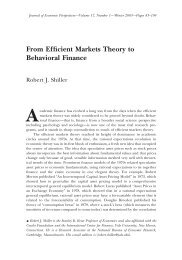Design Management as core competency
Design Management as core competency
Design Management as core competency
You also want an ePaper? Increase the reach of your titles
YUMPU automatically turns print PDFs into web optimized ePapers that Google loves.
Journal of <strong>Design</strong> + <strong>Management</strong> 2009 volume 4<br />
NewSchool for <strong>Design</strong> New York<br />
<strong>Design</strong> <strong>Management</strong> <strong>as</strong> Core Competency:<br />
From “<strong>Design</strong> You Can See” to “<strong>Design</strong> You Can’t See”<br />
Dr Brigitte Borja de Mozota<br />
Director of Research, Parsons Paris School of Art + <strong>Design</strong><br />
brigitte.borja@parsons-paris.com<br />
Abstract<br />
<strong>Design</strong>ers have consistently adapted their practices to the changes of the environmental<br />
context(s), and have tried to invent a better future through new design artifacts. Whenever the<br />
environment changes, design activity creates new design disciplines. The entry point for organizational<br />
design is then b<strong>as</strong>ed on these artifacts, <strong>as</strong> «design you can see” on the companies’ product portfolios<br />
and identities.<br />
Organizational strategy also means adapting the organization to environmental changes, and<br />
developing unique differences that will give the organization a competitive advantage.<br />
Now, organizations have modified further. They develop and select their strategies according<br />
to the challenges and changes that all stakeholders and decision-makers are facing in our postmodern<br />
context. What is also changing is that designers are taking part in this reconstruction, and are among<br />
the decision makers.<br />
Strategic development h<strong>as</strong> changed from external “strategy <strong>as</strong> fit” according to Porter – with<br />
the value chain and its generic strategies in a specific industry - to a “resource-b<strong>as</strong>ed view” (RBV) of<br />
strategy, focused on building a unique competitive advantage b<strong>as</strong>ed on selected internal <strong>core</strong><br />
competencies.<br />
Both the current challenges, and their consequences on strategic decisions, have an impact<br />
on design management. <strong>Design</strong>ers have specific skills that can help in coping with these 21 st century<br />
challenges; therefore they have to adopt new organizational roles that are b<strong>as</strong>ed on skills, processes,<br />
research and knowledge. <strong>Design</strong> management is changing from merely designing the product portfolio<br />
/ product strategy, to a ”design your can’t see” attitude –where design is a <strong>core</strong> <strong>competency</strong> in the<br />
company’s <strong>as</strong>sets.<br />
The new challenges of our contemporary world are giving a renewed popularity to design<br />
activity DNA, such <strong>as</strong> design science, design process and design theory. After presenting the<br />
contemporary challenges and the re<strong>as</strong>ons for this <strong>core</strong> <strong>competency</strong> view of design abilities, this paper<br />
develops a design management model: the “S.P.A.R.K“ model of design management, which focuses<br />
on design <strong>as</strong> Skills, Process, Awareness, Research, and Knowledge.<br />
Due to contemporary challenges, designers now have an entry point at a strategic, decisionmaking<br />
level in organizations and institutions. Is design education ready for this new strategic change<br />
1
Introduction: Changes in design activity are linked to changes in the environmental context<br />
<strong>Design</strong>ers have always been “actors of change “in society. Studying both the history of design<br />
and the history of organizations demonstrates how the environment shapes simultaneously the<br />
activities of designers and managers. Historical ph<strong>as</strong>es in organization theory follow the same<br />
framework of design theories and design processes. There are no changes in design or in business<br />
that are not derived from, or influenced by, changes -- whether social, technological or cultural.<br />
Consequently, there is constantly a contradiction between the reality of the design activity<br />
(through design projects cl<strong>as</strong>sified under many design disciplines, namely ‘tangible design’, or “design<br />
you can see”) and the definition of the design activity (that emph<strong>as</strong>izes design science, design ethics<br />
and processes, design theory -- all intangible design attitude or ways of working, “design you can’t<br />
see”).<br />
As an example, see the present failure of “eco-design” which h<strong>as</strong> not been sufficiently<br />
powerful to change an economic system aimed at overconsumption. Few environmentally aware<br />
designers find a way to follow their consciences whilst thriving economically. Most designers at a<br />
professional level cannot follow their “Victor Papanek” consciences, and instead must apply their skills<br />
to market forces. <strong>Design</strong>ers should play a greater role in transforming society through more win-win<br />
relations on broader, supra systems - but how<br />
Managers and designers alike research changes in the world. From this research ph<strong>as</strong>e,<br />
designers discover new trends in technology and culture, and new needs in and for human behavior,<br />
which they embed in innovative cultural artifacts. Managers agree to develop these artifacts because<br />
they see their coherence with their own research on the global context of change. Just <strong>as</strong> designers<br />
are making new cultural routes tangible through their work, management are developing new strategic<br />
routes according to the new challenges in the outside environment.<br />
So what h<strong>as</strong> changed What are the changes in our postmodern context that all decision<br />
makers, including designers, have to face, andwhat are the challenges facing contemporary decision<br />
makers in society What is their potential, and impact, for and on design<br />
- Managing complexity: This requires applying “design thinking” <strong>as</strong> both a holistic view and <strong>as</strong><br />
“information design“; visualization skills are used to simplify complex environments, and to<br />
build scenarios for system change.<br />
- Globalization and innovation: Companies have to be international; design teams are used to<br />
multicultural working environments, and creativity h<strong>as</strong> no borders.<br />
- Process-oriented companies: Companies have to be more human-centred, customerdriven,<br />
and process-oriented; new information systems have to be invented for Customer<br />
Experience <strong>Management</strong>. <strong>Design</strong>ers have to take a wider view for “user oriented<br />
2
design”;customers are not the only focus and “users” must include customers <strong>as</strong> well <strong>as</strong><br />
employees, shareholders, suppliers, stakeholders, etc.<br />
- Socially Responsible Enterprises: This business model is spreading, and methods are<br />
needed in order to implement it <strong>as</strong> a collective action, <strong>as</strong> “sense building “according to<br />
K.Weick. <strong>Design</strong>ers’ input can go beyond “advanced design” projects in eco-design or<br />
community design, towards inventing and implementing standard processes for change in an<br />
SRE enterprise.<br />
As a consequence of these challenges, the design and design management communities have<br />
two directions for change: the incremental design strategy or “meta design” direction, and the radical<br />
“b<strong>as</strong>ic design“strategy - or <strong>core</strong> <strong>competency</strong> – direction.<br />
The “meta design” direction: incremental design strategy expanding “design you can see“<br />
Existing design disciplines have to redefine themselves according to the changes in the global<br />
context of the service - and aesthetics - b<strong>as</strong>ed economies:<br />
- The aesthetics-b<strong>as</strong>ed economy and the development of new design disciplines must include: design<br />
imaging, perception evaluation, cognitive psychology, ple<strong>as</strong>urable products and sensory design.<br />
- The service economy must develop: service portfolios, <strong>as</strong> well <strong>as</strong> services industries that redefine<br />
their activity in terms of customer experiences and customer relationships.<br />
The “experience economy“is where new “meta design” disciplines are needed, to help<br />
navigate between existing design-discipline silos. This “meta design“direction is an adaptation of<br />
design that is understood <strong>as</strong> design outputs and solutions. The entry points for design in organizations<br />
remain the same. The design demand starts with the company’s products and service portfolios, and<br />
the design brief is to give the brands an emotional difference that customers can see in the market.<br />
This direction is b<strong>as</strong>ed on the cl<strong>as</strong>sic strategy definition of Michael Porter: a strategy <strong>as</strong> fit in<br />
selecting a unique value chain in a specific market after a SWOT analysis of internal strengths and<br />
weaknesses, and the external opportunities and threats of your competition. <strong>Design</strong> is a tangible<br />
competitive advantage that is valued through improved sales, a brand image and market shares in a<br />
defined market.<br />
Finally, we have entered the “creative economy“ in which design is an industry that is part of<br />
the bigger picture of creative industries, and where creative industries are now understood <strong>as</strong> having a<br />
national competitive edge. Postmodern organizations are collages that value creativity. Managers in<br />
postmodern organizations are reinventing a management that enhances autonomy and individual<br />
creativity. <strong>Design</strong> managers in postmodern organizations enhance autonomy and individual creativity:<br />
3
co-design, user-centered design, inclusive design, etc. The postmodern design manager is seen <strong>as</strong> an<br />
artist or a theorist who focuses on creativity, freedom and individual responsibility.<br />
For example, the design manager focuses on self-entrepreneurship on “deconstructing<br />
hierarchical power“ through a galaxy of projects. <strong>Design</strong> isnow valued <strong>as</strong> giving voice to silence, or<br />
previously overlooked or unheard minorities.<br />
The <strong>core</strong> <strong>competency</strong> direction: radical design strategy <strong>as</strong> “design you can’t see“<br />
The traditional vision of strategy <strong>as</strong> fit is not helpful in solving the previously discussed<br />
challenges of decision makers. Therefore, another strategic theory h<strong>as</strong> emerged, emanating from a<br />
resource-b<strong>as</strong>ed perspective <strong>as</strong> well <strong>as</strong> a collective-learning objective. This RBV view of strategy<br />
focuses on internal development, but also on pushing the traditional boundaries of organizations<br />
through network management. This resource-b<strong>as</strong>ed theory of building a sustained competitive<br />
advantage h<strong>as</strong> developed since Wernerfelt’s article in 1984, which responded to the changes of<br />
organizations’ environments.<br />
A resource refers an <strong>as</strong>set or input to production that an organization owns, controls, or h<strong>as</strong><br />
access to on a semi-permanent b<strong>as</strong>is. Therefore, the resource-b<strong>as</strong>ed theory should be understood by<br />
design managers <strong>as</strong> a paradigm shift from the structure–conduct–performance (S-C-P) paradigm,<br />
where competitive advantage is primarily determined externally by environmental factors:<br />
differentiating from my competitors in an industry. This S-C-P view of design strategy is reactive. It is a<br />
tangible view of the company’s potential in regards to its competitive environment.<br />
Resource-b<strong>as</strong>ed management highlights how the possession of internal, valuable, rare,<br />
inimitable and non-substitutable resources may result in sustained superior performance. The<br />
Resource-B<strong>as</strong>ed View of a firm’s competitive advantage emph<strong>as</strong>izes the importance of the invisible<br />
internal <strong>as</strong>sets such <strong>as</strong> the skills and values of “design you can’t see”.<br />
Pralahad and Hamel argue that information-b<strong>as</strong>ed, invisible <strong>as</strong>sets -- such <strong>as</strong> technology,<br />
customer trust, brand image, corporate culture and management skills -- are the real resources of<br />
competitive advantage, because they are both difficult and time consuming to accumulate, and may<br />
also be used in multiple ways simultaneously. To design managers, it means promoting design<br />
abilities <strong>as</strong> rare, inimitable, and non-substitutable; it also means managing design with a long-term<br />
perspective of sustained, competitive advantage rather than a short-term view of project management.<br />
It is refocusing on design <strong>as</strong> being skills that are pertinent – even essential -- in developing a<br />
corporation’s intangible <strong>as</strong>sets.<br />
A more process oriented view of strategy in the new millennium part of the<br />
strategic discourse embraced a reconstruction view in which market<br />
boundaries and industries can be reconstructed by actions and beliefs of<br />
industry players.– (Johansson &Woodilla 2009)<br />
4
See also the so-called Kim and Mauborgne “Blue Ocean strategy”, which creates an<br />
uncontested market space that makes competition irrelevant. Strategy is dynamic, rather than solely<br />
concentrated on the competitors. In this process the view of strategy is to valorize; design<br />
management focuses on design process management rather than design project management.<br />
(Figure 1)<br />
Figure 1:The design process in business: the design function (Borja de Mozota 2006)<br />
The excitement surrounding “design thinking”, <strong>as</strong> well <strong>as</strong> the new MBA often praised by Roger<br />
Martin in business media, is a good example of this radical design strategy. So why should designers<br />
now return to the b<strong>as</strong>ic, “what is design“ activity Quite simply, it is the skills of the designers that will<br />
help decision makers facing their current challenges. The entry point for design within organizations is<br />
not only the object to be designed for the company portfolio, but rather it is some specific skills of<br />
designers.<br />
Figure 2 is a synthesis of designers’ skills, and -- in italics -- the skills that are most relevant to<br />
our present context:<br />
5
Knowledge Attitude Values Applied skills Understanding<br />
skills<br />
<strong>Design</strong> process<br />
Risk-taking<br />
Managing uncertainty<br />
Practical design skills<br />
Prototyping<br />
Drawing ability<br />
Observation<br />
Material Originality Creative techniques Researching<br />
Lateral thinking<br />
Market Anticipating future Commercial skills Logical thinking<br />
trends<br />
Forward thinking<br />
Technology Proactive in Communication skills Analyzing<br />
developing<br />
(Presentation and Prioritizing<br />
relationships<br />
report writing) Structuring problems<br />
User awareness Open-minded Computer skills Scenario building<br />
Narrative<br />
Culture<br />
Understanding <strong>Design</strong><br />
for Synthesizing<br />
multidisciplinary manufacture<br />
Holistic thinking<br />
context<br />
Aesthetic awareness Focusing on usability Project management Intuitive thinking &<br />
action<br />
Human factors Attention to detail Optimization Consumer and<br />
stakeholder needs<br />
Manufacturing<br />
process<br />
Learning from errors Team work Human empathy<br />
Figure 2: <strong>Design</strong> skills: in italics, the strategic skills for now<br />
And one of most important skill is “holistic thinking” or the designers curiosity, their open-mindedness<br />
that transcends existing barriers of industries silos .<br />
The design agency IDEO h<strong>as</strong> branded designers’ skills under the term “design thinking”, and<br />
their global success -- the Davos summit, Procter & Gamble, the design school that they have opened<br />
at Stanford University -- is evidence of the coherence between their discourse with the needs of both<br />
CEOs and politicians worldwide. <strong>Design</strong> science <strong>as</strong> entrepreneurial science on a society and world<br />
level.<br />
This, therefore, is where we must to return to our introductory remark on the contradictions in<br />
the design community, between the reality and the definition of the design profession. In the design<br />
community, and particularly among academics in design, everyone is familiar with: Simon’s design<br />
science, Donald Schon’s reflexive practitioner, and Willemien Visser’s vision of design <strong>as</strong> a<br />
construction of representations. Writers such <strong>as</strong> Bryan Lawson or Nigel Cross have explained<br />
designers’ ways of knowing and of thinking. Indeed every designer will probably refer individually to<br />
one or more of these concepts: design activity <strong>as</strong> problem solving, <strong>as</strong> part of the industrial process, <strong>as</strong><br />
social engineering, <strong>as</strong> a question, <strong>as</strong> a research activity, <strong>as</strong> a discourse rather than a thing, <strong>as</strong> a label,<br />
6
<strong>as</strong> an art form, etc. Why, therefore, is it that our current context requires us to return to the most b<strong>as</strong>ic<br />
of design definitions<br />
<strong>Design</strong> science is what is needed to change the strategic definition process within companies.<br />
Strategy definition is also becoming a complex and “wicked problem”; comparing and competing with<br />
one’s rivals on market share targets in well documented, static industrial sectors will provide no<br />
sustained advantage. This is not the way the economy is working now, after the digital revolution.<br />
Where is your “competition“ when industries’ frontiers are blurring, when Amazon and Google<br />
are the new entrants’ competition for traditional industries such <strong>as</strong> editing, publishing and general<br />
commerce Consequently, all strategic methods b<strong>as</strong>ed on competition analysis, whether used by<br />
designers or by managers, are less and less relevant <strong>as</strong> decision-making tools.<br />
In this transitional economy, where any individual on the Internet is challenging the role of<br />
institutions to regulate the economy, new skills are needed to innovate in your relationship to the<br />
world. <strong>Design</strong> activity becomes an agent of change for prototyping the new socio-technical system that<br />
h<strong>as</strong> to be invented, <strong>as</strong> well <strong>as</strong> for helping companies manage the transition between the old, and the<br />
emerging socio-technical systems.<br />
Recently, the way that designers think h<strong>as</strong> become incre<strong>as</strong>ingly interesting to business<br />
managers because it is often seen <strong>as</strong> creative and holistic rather than specialist and bureaucratic.<br />
(See Figure 2: designers ’skills.)The emerging roles for designers in the 21st century, according to the<br />
previously discussed challenges in a complex world of stakeholders are: (Inns2007)<br />
-<strong>Design</strong> <strong>as</strong> a facilitator of thinking: the designer in the 21 st century will need to know how to mobilize<br />
and energize the thinking of others.<br />
-<strong>Design</strong> <strong>as</strong> a visualizer of the intangible: not a new role but an extended one, visualization of systems,<br />
relationships, emotions, experiences and networks.<br />
-<strong>Design</strong> <strong>as</strong> a navigator of complexity: in a world of complexity and ambiguity, designers have to<br />
understand complexity theory in order to help others understand complexity.<br />
- <strong>Design</strong>er <strong>as</strong> a mediator of stakeholders:“meta design” with tools that can allow multiple stakeholders<br />
to debate a complex issue.<br />
-<strong>Design</strong> <strong>as</strong> a coordinator of exploration: coordinate the exploration of relevant technical and contextual<br />
sources to maximize creativity in the early stages of a design.<br />
What are these new challenges, and why is design the best solution<br />
Understanding the link between design <strong>as</strong> a <strong>core</strong> <strong>competency</strong> and the new “person-centric<br />
“economy may be seen through two examples: the healthcare industry and the travel industry.<br />
7
How might design inform healthcare and vice versa <strong>Design</strong> tends to be person–centric, while<br />
healthcare is rather pathology-centric. However, individuals have less revenue for managing illness in<br />
the new economy, so they take care of themselves differently and/or they wish to avoid hospitals. It is<br />
therefore no longer the illness or pathology --such <strong>as</strong> diabetes -- that defines the medical industry, but<br />
rather the individual suffering from this long term illness. How can he or she co-design his or her own<br />
way of living with the pathology within a person-centric system and entrepreneurial attitude<br />
Consequently, we find the rise of service design, co-design/inclusive design, system design, platform<br />
design, etc. in national healthcare systems worldwide.<br />
Another example is seen in the travel industry. Traditionally it w<strong>as</strong> organized by where you<br />
wanted to travel, how you wanted to travel -- train, car, plane—and how much you wanted to pay for<br />
your hotel room. Now, simply by looking into the number of occurrences in Google searches, you will<br />
see websites answering these traditional segmentation criteria; however the most frequently cited<br />
websites are referring to a new criterion --travelling alone. So “being alone” is a new segmentation<br />
criterion for travel, but could also be used for innovative ways in arranging service industries. After all,<br />
you may be alone at some time of your life for many different re<strong>as</strong>ons: hence the rise of the<br />
“concierge“ services successes.<br />
Therefore I -- first <strong>as</strong> a person, then <strong>as</strong> a person being “alone” -- am reconstructing many<br />
different industries, and pushing alliances between traditionally competing actors. Consequently, in<br />
this individual economy – the DOWN/UP economy–the brand power of organizations is fundamental in<br />
shaping our mental images that this brand, rather than another brand, is best for ME regardless of<br />
whatever product or services it offers. The power is in “ME” <strong>as</strong> a human being, with the power of<br />
individual choice.<br />
The “complexity economy” means adopting this “DOWN/UP”, person-centric attitude. This,<br />
therefore, is the re<strong>as</strong>on for the “design thinking“, user-driven design attitude: an empathetic attitude<br />
gives designers new roles. <strong>Design</strong>ers’ research skills and attitudes mean that the design profession<br />
can embrace larger issues such <strong>as</strong> social innovation and, <strong>as</strong> such, invent new business models.<br />
<strong>Design</strong>ers and strategists share an entrepreneurial spirit.<br />
<strong>Design</strong>ers need to explore how design knowledge might be exported and imported across the<br />
traditional borders of design. A key question to consider is:”Can designers industrialize socially<br />
responsible solutions” (Morelli,2007)<strong>Design</strong>ers need to understand the concepts and values of their<br />
skills in order to design from outside the traditional boundaries.<br />
<strong>Design</strong> <strong>Management</strong> <strong>as</strong> <strong>core</strong> <strong>competency</strong><br />
What h<strong>as</strong> changed in <strong>Design</strong> <strong>Management</strong>, from seeing design primarily <strong>as</strong> design strategy<br />
and managing design projects, to recognizing design <strong>as</strong> an integral function of all organizations In<br />
becoming a function of organizations, design can be selected <strong>as</strong> a <strong>core</strong> <strong>competency</strong>. Our model<br />
<strong>Design</strong>ence (Borja de Mozota 2006) h<strong>as</strong> given evidence for four types of design values; ”design you<br />
8
can’t see “ through the managerial process value of design and the transformational value of design<br />
skills have now been well-documented.<br />
Our <strong>as</strong>sumption is that designers should change from their focus on product and service<br />
portfolio or product strategy and from design discipline-centered views of their territory.<br />
Example: Current <strong>Design</strong> territory in organizations to be expanded :(Moultrie et al, 2008).<br />
-<strong>Design</strong> in the communication, promotion and delivery of products and services and in the creation<br />
and communication of the identity of the business.<br />
-<strong>Design</strong> <strong>as</strong> the creation of products and services.<br />
-<strong>Design</strong> within the business: design of the organization’s operating environment workplaces, design of<br />
business processes and systems.<br />
<strong>Design</strong> is an <strong>as</strong>set giving value to other intangible <strong>as</strong>sets in organizations. This <strong>core</strong><br />
<strong>competency</strong> view of design is b<strong>as</strong>ed on the design profession’s myriad capabilities. The changes in<br />
the global context have created a new model of postmodern organizations, where designers have new<br />
roles to play. <strong>Design</strong> skills are for reinventing new business models.<br />
Rather than seeing the present system <strong>as</strong> more complex, it is the system that h<strong>as</strong> to be<br />
reinvented. New business models and new industries will emerge that will change the balance of our<br />
socio-technical system. Also, in this transition period, “design thinking” <strong>as</strong> holistic and “user oriented“<br />
will coax the change. <strong>Design</strong>ers’ empathy is a key factor. Nonetheless, holistic systemic thinking for<br />
inventing value for all stakeholders is in concordance with the shift in strategy definition (Borja de<br />
Mozota & Kim 2009, Figure 3).<br />
9
Figure 3:From design strategy <strong>as</strong> fit to design strategy <strong>as</strong> a resource (Borja de Mozota& Kim 2009)<br />
What h<strong>as</strong> changed in management is the emergence of a mental image of design <strong>as</strong> a<br />
horizontal function in organizations and institutions. B<strong>as</strong>ed on Skills (figure 1),on Process (figure 2), on<br />
Awareness, on Research and on Knowledge for improving organizations’ capital -- whether human,<br />
knowledge, cultural, or technological (figure 3) -- we call this <strong>Design</strong> <strong>Management</strong> model the<br />
S.P.A.R.K model of <strong>Design</strong> <strong>Management</strong> (Borja de Mozota & Dong 2009).<br />
Conclusion<br />
Unlike managing design <strong>as</strong> a competitive advantage, managing design <strong>as</strong> a <strong>core</strong> <strong>competency</strong><br />
is high-risk and needs long-term vision; therefore many companies have been reluctant to invest in<br />
building design capabilities. However, some companies have understood that building a sustainable,<br />
competitive advantage requires adopting a long-term resource view of design management in order to<br />
improve the probability of success in the present chaotic business environment.<br />
Managers have to integrate design theories in their organizational al theories, and see “design science”,<br />
design theories and conceptual models <strong>as</strong> skills for designing their organizational platforms, structures<br />
and organizational studies.<br />
10
The problem, however, is that even though designers have this potential to work at a higher<br />
strategic level of organization, they are not yet trained to do so. This is a challenge for design<br />
education. <strong>Design</strong>ers have to reinvent the guilds, and to become more effective entrepreneurs in order<br />
to help society at large to face the changes in this transitional period between two socio-technical<br />
systems. They also have to design their profession <strong>as</strong> a part of the creative industries.<br />
References<br />
Borja de Mozota, Brigitte. “The four powers of design:A value model in <strong>Design</strong> <strong>Management</strong>”.<strong>Design</strong><br />
<strong>Management</strong> Review. Volume 17 (Spring 2006), pp 42-53.<br />
Borja de Mozota, Brigitte and Kim Bo Young. “Managing <strong>Design</strong> <strong>as</strong> a Core Competency:Lessons from<br />
Seven Korean companies”.<strong>Design</strong> <strong>Management</strong> Review. (In press, 2009).<br />
Borja de Mozota, Brigitte and Dong Hua. “Towards a theory of <strong>Design</strong> <strong>Management</strong>:can theoretical<br />
models define its territory A transcultural conversation between design and business”. D2B2,<br />
<strong>Design</strong> To Business conference. Conference Paper. Tsinghua University, Beijing China. April<br />
2009.<br />
Inns Tom.(ed).<strong>Design</strong>ing for the 21 st century: interdisciplinary questions and insights. Gower: 2007,<br />
pp.21-26.<br />
Johansson, Ulla and Jill Woodilla.“Towards an epistemological merger of design thinking,strategy<br />
and innovation”. 8 th European Academy of <strong>Design</strong> conference. Conference Paper. The Robert<br />
Gordon University,Aberdeen Scotland. April 2009.<br />
Morelli, Nicola.“Social innovation and new industrial contexts:can designers “industrialize” socially<br />
responsible solutions”<strong>Design</strong> Issues. Volume 23 (Autumn 2007), pp 3-21.<br />
Moultrie, James et al. “<strong>Design</strong> funding in firms: a conceptual model of the role of design in industry“.<br />
International DMI Education Conference on <strong>Design</strong> Thinking. Conference Paper. ESSEC<br />
Business School, CergyPontoise,France. April 2008.<br />
Visser, Willemien, The cognitive artifacts of designing. Lawrence Erlbaum Associates, 2006. p. 116.<br />
11


